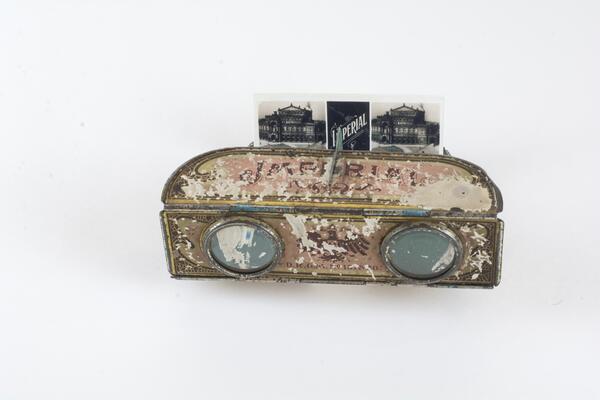Using a miniature device with two lenses — a stereoscope — you can view special “three-dimensional” photos, stereograms. The optical device was made at the end of the 19th century — early 20th century.
Stereoscopes were made in the form of an episcope or a diascope. With an episcope, images of opaque objects — drawings, paintings or various objects — were viewed on the screen. With a diascope, one could look through the images on special transparent plates — diapositives. The stereoscope from the museum’s collection belongs to the second type and it is in working condition.
The episcopes and diascopes had a similar dual design. The viewing cards consisted of two parts. When a person looked into the optical device, with one eye he saw the left card and with the other eye he saw the right one. The principle by which the device worked was based on the binocularity of human vision: the brain combines what each eye sees into a whole picture. An image was placed on one card, and the perspective of the same picture was shifted slightly on the other card. When viewed, they overlapped and became three-dimensional.
The first device appeared in 1829. It was called Elliot’s slit stereoscope — after the inventor, a teacher of Mathematics from Edinburgh. The device was a box in which a special slit was cut. One could look through it at stereograms — three-dimensional landscapes, applied to a transparent substrate.
In 1832, the English physicist Charles Whitston designed a stereoscope with mirrors, which he placed in front of the person’s eyes at an angle of 45 degrees. The halves of the stereograms in this device were viewed through them: the mirrors formed a right angle with each other and redirected light from the two drawings fixed on the walls of the device.
In 1849, the inventor of the kaleidoscope, David Brewster, inserted eyepieces into the device. They enlarged the image — so observers’ eyes were less tired. But Brewster could not establish mass production of his stereoscopes in England and sold the rights to the invention to the Frenchman Jules Debosque. In 1851, Debosque presented the product at the World’s Fair, where it won the approval of the public and Queen Victoria. Brewster demonstrated how the device worked, and Debosque gave her a stereoscope with a set of stereograms.
In 1854, the British London Stereoscopic Company proclaimed the slogan:
Stereoscopes were made in the form of an episcope or a diascope. With an episcope, images of opaque objects — drawings, paintings or various objects — were viewed on the screen. With a diascope, one could look through the images on special transparent plates — diapositives. The stereoscope from the museum’s collection belongs to the second type and it is in working condition.
The episcopes and diascopes had a similar dual design. The viewing cards consisted of two parts. When a person looked into the optical device, with one eye he saw the left card and with the other eye he saw the right one. The principle by which the device worked was based on the binocularity of human vision: the brain combines what each eye sees into a whole picture. An image was placed on one card, and the perspective of the same picture was shifted slightly on the other card. When viewed, they overlapped and became three-dimensional.
The first device appeared in 1829. It was called Elliot’s slit stereoscope — after the inventor, a teacher of Mathematics from Edinburgh. The device was a box in which a special slit was cut. One could look through it at stereograms — three-dimensional landscapes, applied to a transparent substrate.
In 1832, the English physicist Charles Whitston designed a stereoscope with mirrors, which he placed in front of the person’s eyes at an angle of 45 degrees. The halves of the stereograms in this device were viewed through them: the mirrors formed a right angle with each other and redirected light from the two drawings fixed on the walls of the device.
In 1849, the inventor of the kaleidoscope, David Brewster, inserted eyepieces into the device. They enlarged the image — so observers’ eyes were less tired. But Brewster could not establish mass production of his stereoscopes in England and sold the rights to the invention to the Frenchman Jules Debosque. In 1851, Debosque presented the product at the World’s Fair, where it won the approval of the public and Queen Victoria. Brewster demonstrated how the device worked, and Debosque gave her a stereoscope with a set of stereograms.
In 1854, the British London Stereoscopic Company proclaimed the slogan:



